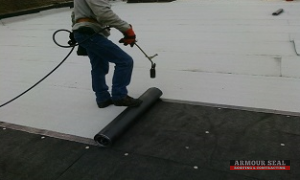Black-top
Black-top is an aliphatic compound and in practically all cases a side-effect of the oil business. Some black-top is fabricated from oil for the expected reason, and this is restricted to great black-top delivered for longer-enduring black-top developed Flat Roofing Bristol (BUR). Black-top ages through photograph oxidation advanced by heat. As it ages, the pavements dissolve point rises and there is a deficiency of plasticizers. As mass is lost, the black-top psychologists structure a surface like a crocodile skin. Black-top separates gradually in water, and the more openness the quicker the debasement. Black-top additionally breaks down promptly when presented with oils and a few solvents. There are four sorts of roofing black-top. Each type is made by warming and blowing with oxygen.

The more extended the cycle the higher the liquefy point of the blacktop. Dead-level roofs where Type I black-top is utilized as the flood and rock glue perform almost as well as coal tar. Black-top roofs are likewise economical by reestablishing the existence cycle by making fixes and recoating with viable items. The interaction can be rehashed as fundamental at huge expense to investment funds with next to no effect on the climate. Black-top BUR is comprised of different layers of supporting employs and black-top shaping an overt repetitiveness of waterproofing layers. The reflectivity of developed roofs relies upon the surfacing material utilized. Rock is the most widely recognized and they are alluded to as black-top and rock roofs. Black-top corruption is a developing concern.
EPDM
- Ethylene propylene diene monomer elastic (EPDM) is a manufactured elastic most regularly utilized in single-employ roofing since it is promptly accessible and easy to apply. Seaming and enumerating have developed throughout the long term and are quick, straightforward, and dependable with numerous films including manufacturing plant applied tape, bringing about a quicker establishment. The expansion of these tapes has decreased work by as much as 75%. It is a minimal expense layer, however, when appropriately applied in fitting spots, its justified life expectancy has arrived at 30 years and its normal life expectancy has arrived at 50 years.
- There are three establishment techniques: ballasted, precisely joined, and completely stuck. Ballasted roofs are held set up by enormous round stones or sections. Precisely appended roof layers are held set up with nails and are appropriate in certain applications where wind speeds are not generally high. A downside is that the nails enter the waterproof layer; assuming accurately secured the film is “self-gasketing” and won’t spill. Completely stuck establishment techniques give the longest exhibition of the three strategies.
- The most exceptional EPDM is joined with a polyester wool backing and manufactured with a licensed hot-liquefy cement innovation which gives reliable bond strength between the downy support and the layer. These outcomes to a great extent kill shrinkage of the item, while as yet permitting it to extend up to 300% and move with the structure through the seasons. Downy supported EPDM has a tear strength of 39.9 kN/m (228 lbs/in) contrasted with 13.1 kN/m (75 lbs/in) of that without the wool support, multiple times the strength of non-built up films.
CPE and CSPE
Chlorosulfonated polyethylene (CSPE) and chlorinated polyethylene (CPE) are nonvulcanized engineered elastic roofing materials that were utilized for roofing materials from 1964 until their practically complete evacuation/vanishing from the market in 2011. It is all the more prominently referred to and alluded to as Hypalon. The item is normally supported, and contingent on the producer, creases can be heat welded (when the two layers were fresh out of the box new) or stuck with a dissolvable based glue. Over the long haul, nonetheless, the materials fix and gain properties like most thermoset materials like neoprene or EPDM. After natural worries in the last part of the 1990s organizations started to feel compelled in regard to a portion of the normal cement and holding synthetic compounds, and a few locales passed guidelines restricting the utilization of CSPE films. this made numerous producers scramble to make better approaches to fabricate the roofing materials, raising expenses as well as worries with respect to life span.

